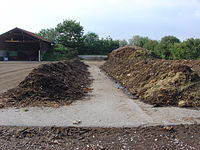
Photo from wikipedia
Abstract On-farm composting is suitable to recycle agricultural biomasses in mature and stable organic matter that can be applied to improve the general soil conditions, such as physical, chemical, hydro-physical,… Click to show full abstract
Abstract On-farm composting is suitable to recycle agricultural biomasses in mature and stable organic matter that can be applied to improve the general soil conditions, such as physical, chemical, hydro-physical, texture, and refresh the provided ecosystem services for human well-being. Quality compost have a high potential in sustaining plant health through disease suppressiveness mechanisms against soil-borne pathologies; however, this property needs to be standardized. In this work, leafy vegetable/chipped energy cardoon residues have used as common starting feedstock in three comparative composting piles differentiated for the aeration method (passive, active and manual turning). Compost from both passively and actively aerated static piles showed higher suppressive properties against Lepidium sativum damping-off caused by Rhizoctonia solani and Sclerotinia minor. The enhanced suppressiveness was found associated to increased population levels of fungi and bacteria, combined with larger microbial activity and catabolic diversity. Compost community levels of physiological profiles were distributed within PCA biplots according to the gradient of suppressiveness and, putatively, their C-food bioavailability degree. The observed differences in stimulation and selection of microbiota may be related to specific molecular compost features. The two suppressive compost revealed either a distinct lipid composition, assessed by thermochemolysis and to the preservation of readily biodegradable molecules by lignocellulosic components, as detected in NMR analyses. Findings indicate the relevance of on-farm composting methods in shaping compost suppressive functions and give new information about the provisioning of bio-based products for sustainable plant disease management.
Journal Title: Biological Control
Year Published: 2019
Link to full text (if available)
Share on Social Media: Sign Up to like & get
recommendations!